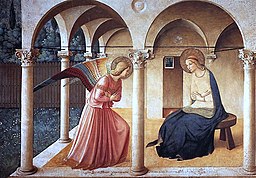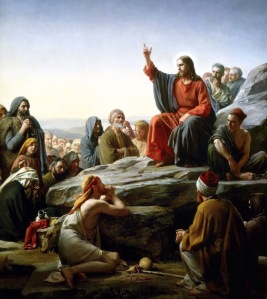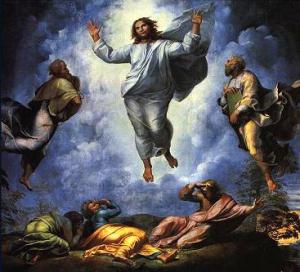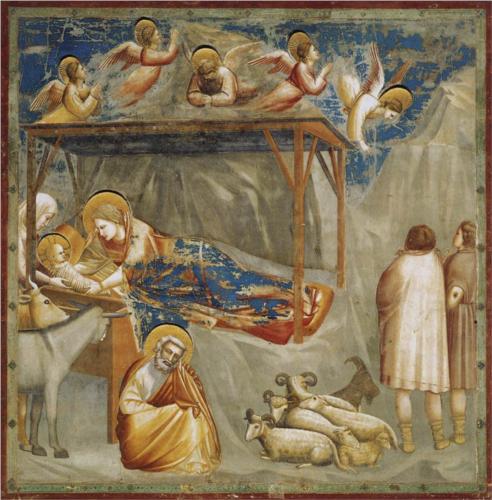
Mary’s Vision: The Archangel Gabriel
During times of crisis, especially when serious health related issues are at stake, the occurrence of visions or other paranormal phenomenon is not as unusual as one might expect. Many people have been led to believe that seeing a vision either indicates saintliness or insanity—not a comfortable point of view to hold when an angel drops by! As a result, people tend to be very cautious about sharing their experience of visions. However, I found that quite a number of average people have visions. In my classes, many students recounted seeing visits by supernatural beings like Jesus or angels or the presence of a comforting divine light. For the most part, these experiences come at traumatic or life changing times in someone’s life.
These phenomena can be thought of as expressions of pure intuition, healing energy that breaks through when the veil between this world and other realities is made thin by the magnitude of a mind-bending reality a person is facing. The reality to be encountered can be traumatic such as life threatening surgery, a sexual assault, or death of a loved one. However, it may not necessarily be negative. It could be something profoundly wonderful such as the gifting of a special and life changing calling as Mary experienced with the visit of the Archangel Gabriel who heralded her role to be the mother of Jesus.
At these times, visions come to tell the distraught person that the overwhelming reality encountered is not all there is and will not have to be born alone—that something more abides giving comfort, love and insight. In Mary’s case, she was told she had found favor with God and that the power of the Most High would overshadow her.
Visions vs. Hallucinations
Some people may be confused by the difference between visions and hallucinations. According to Morton Kelsey, in Dreams: A Way to Listen to God, Paulist Press, 1978, visions and hallucinations are very different and easy to distinguish. He says the vision is “attributed to the inner world” by the beholder while a hallucination is “attributed to the physical world.” Visions can be very practical and helpful, tending to bring gifts like guidance and comfort. Hallucinations, on the other hand, are taken to be actually there in the physical world when they aren’t perceived by others, and tend to instill fear and other negative feelings into the beholder. Hallucinations can come as a side effect of certain drugs or medications.



The Sermon on the Mount –
Carl Heinrich Bloch
Luke 11 begins with the Lord’s Prayer. Edgar Cayce, Dana Williams and Philip St. Romain, among others, have commented on the correlation of the seven chakras of Hinduism to phrases in the Lord’s Prayer. Here is my version of an extended Lord’s Prayer which makes a reasonable correlation to the seven chakras, perhaps in a different way suggested by others. The words in bold are either the original words to the Lord’s Prayer as it is often said in Christian communities or a close proximity with more added to show a correlation to a chakra. The words in italics suggest the chakra indicated with the suggested correlation in bold following.
Our Father Who Art In Heaven, help us to see that the greatest service we can give to others is to continually transform ourselves into clearer images made in your likeness. When we feel the emptiness inside, it is so tempting to seek without for the wealth, power, and recognition needed to help us feel more assured in our service to others. Instead, help us to see ourselves as we truly are: beings of light and energy already complete with our own God-given power, creativity and blessings which only need to be lit up brightly by Your love—and appreciated by ourselves.
(7th Chakra: Center for Spiritual Purpose)
In hallowing and making holy Your name we allow the fullness of Your grace to flood into us from Your home above into the top of our heads, making space for
(6th Chakra: Center for Spiritual Vision)
Thy kingdom to come inside our minds, and then…
(5th Chakra: Center for Decision Making and Communication)
Delightfully invade our throats so that we can commit to and make the most courageous proclamation possible: Thy Will Be Done, which is only to make us ever more like the impossibly loving, powerful and wise You.
(4th Chakra: Center for Joining the Energies Above and Below to Heal and Relate)
At this point You have gone further into us, invading our hearts like an insistent lover, truly commingling the divine with the human so we can truly say, “On earth as it is in heaven!”
(3rd Chakra: Center for Managing Power and Structure)
But because we need earthly bread and other good things as well as heavenly bread, we can now ask freely and confidently of you, “Give us our daily bread” to fill the aching stomach and other earthly wants and needs. As a lover, it is Your joy to grant our wishes.
(2nd Chakra: Center for Creativity within Boundaries)
Still your loving does not stop. It reaches further into our most creative places where we give life and make love prosper in our relationships. Here, the loving comes easy, but the temptation to trespass on others’ boundaries is great and the experience of being trespassed and betrayed is all too frequent, making us need to ask for the grace of forgiveness for ourselves and others.
(1st Chakra: Center for Security and Survival)
By now, You have thoroughly penetrated our innermost recesses even to the very bottom of our spines where Your loving presence seeks to cast out any remnant of temptation so that you may deliver us from all evil, and let us know the most blessed peace and well-being.
Now that You are so thoroughly within us, we are ablaze with light. Let us shine our light on each other and the world in our work and in our relationships with others. Let us send light and loving energy to all who are sick, lonely, and hurt by war. For Thine is the kingdom, the power and the glory, forever and ever amen.



The Transfiguration by Raphael
Luke 9 is about bringing the disciples to the mountain top, literally and figuratively, and then sending them into the world while letting them know what the cost of discipleship is all about. In the process, a growth of intuitive insight occurs among the disciples to the point where they can see the full revealing of Jesus as He is, beyond the carpenter from Nazareth. They can see his essential energy field in all its glory and wonder, as well as those of Moses and Elijah who set in motion the forces of spiritual tradition that led to Jesus.
A Call to Let Go
After having chosen his disciples, Jesus sends them out with little in the way of backup support to proclaim the Good News and to heal. In a sense, it is the pulling away of the usual supports we are accustomed to for a greater good. The call to grow one’s intuition often involves a call to let go of the things we previously relied on for support.
A Discovery of Miraculous Abundance
Early on in the call to open the third eye of understanding, the seeker becomes aware that highly developed spiritual persons can summon and bring abundance of resources and good health, defying our common perspective that the pie is only so large. The disciples witness this so many times they begin to believe it themselves. They begin to see that life can be lived on different terms. There will always be enough with the grace of God.
The Recognition of God’s Presence among Us
Jesus constantly asks His disciples who they think He is, testing their depth of spiritual awareness. When Peter answers that Jesus is the Messiah, Jesus knows Peter’s eyes have been opened. In a sense, all of us are constantly being asked the same thing. Can we see the presence of God in our lives? If Jesus is the God for us, can we recognize Him here among us now? As with Peter, when we can see God even in the lowliest person, we have reached a significant point of spiritual development.
Before the disciples recognized Jesus’ true nature, the demons inside possessed people were the only ones who recognized Him. It is much the same within ourselves, our demons torment us, and make us aware until we can recognize the divine and be healed. Their coming to the fore is almost necessary to precede the healing call of the divine.
The Mountain Top Experience
Like Peter and the apostles, we are usually relaxed, half asleep or in a state of meditation when suddenly there is a shift of consciousness and we can see auras and energy fields. In this state the disciples witness Jesus in splendor, along with the great spiritual leaders who preceded him. Like us, the disciples want to capture this precious moment and make order out of it by constructing something to make it permanent. They want to build booths to contain the wonder they have just seen just as we want to write about, paint, sing, memorialize or “churchify” our spiritual experiences.
The Need to Go Out Into the World
Jesus knows it is not only about the mountain top experience. It is also about acting as His disciples at a time when he won’t be around, spreading the news of what they have just witnessed and doing the miraculous things He has done. He explains what this entails: the profound insight demands an equally profound and unconditional call to action. It is the basis for the call to action.


By Daniel J. Harrington, S.J.
The New Testament contains two Christmas stories, not one. They appear in Matthew 1–2 and Luke 1–2. They have some points in common. But there are many differences in their characters, plot, messages, and tone.
In the familiar version of the Christmas story, Mary and Joseph travel from Nazareth to Bethlehem. Because there was no room in the inn, the baby Jesus is born in a stable and placed in a manger. His humble birth is celebrated by choirs of angels and shepherds, and he is given precious gifts by the mysterious Magi. This version freely blends material from the two biblical accounts. It has become enshrined in Christmas carols and stable scenes as well as the liturgical cycle of readings during the Christmas season.

Giotto’s “Nativity, Birth of Jesus” from Scrovegni (Arena) Chapel, Padua, Italy c. 1304-1306.
My purpose here is not to criticize blending the two Christmas stories or to debate the historicity of the events they describe. What I do want to show is that by harmonizing the two stories we may be missing points that were especially important for Matthew and Luke, respectively. I want also to suggest that appreciating each biblical account separately might open up new perspectives on the infancy narratives for people today.
In The Bible and the Believer: How to Read the Bible Critically and Religiously, Marc Z. Brettler, Peter Enns, and I explore how each of our religious traditions—Jewish, Evangelical, and Catholic—tries to bring together the modern historical-critical reading of the Bible and contemporary religious faith and practice. There are, of course, many differences among us. But there are some principles we hold in common: the value of reading biblical texts in their original historical settings, the need for careful analysis of the literary dimensions of each text, and respect for what seems to have been the intentions of the original author. Applying these principles to the two Christmas stories in the New Testament will reveal more clearly their historical significance, distinctive literary character, and theological riches.
Matthew wrote his Gospel in the late first century CE, perhaps in Antioch of Syria. He was a Jewish Christian writing primarily for other Jewish Christians. He wanted to show that the legacy of biblical Israel was best fulfilled in the community formed around the memory of Jesus of Nazareth. Now that the Jerusalem temple had been destroyed and Roman control over Jews was even tighter, all Jews had to face the question: how is the heritage of Israel as God’s people to be carried on? Matthew’s answer lay in stressing the Jewishness of Jesus.
This setting helps to explain why Matthew told his Christmas story as he did. He begins with a genealogy that relates Jesus to Abraham and David, while including several women of dubious reputation who nonetheless highlight the new thing God was doing in Jesus. Next, he explains how the virginal conception of Jesus through the Holy Spirit fulfilled Isaiah’s prophecy (7:14), and how Jesus the Son of God became the legal Son of David through Joseph. Besides Jesus, Joseph is the main character in Mathew’s Christmas story. Guided by dreams like his biblical namesake, he is the divinely designated protector of Mary and her child Jesus.
The Magi story in Matthew 2 is part of a larger sequence that involves danger for the newborn child and his parents. When King Herod hears about the child “King of the Jews” as a potential rival for his power, he seeks to have Jesus killed. As a result the family flees to Egypt, while Herod orders the execution of all boys under two years old in the area of Bethlehem. Only after Herod’s death does the family return to the Land of Israel, though to Nazareth rather than Bethlehem. At each point in their itinerary, the family is guided by dreams and texts from the Jewish Scriptures.
In his Christmas story Matthew wants us to learn who Jesus is (Son of Abraham, Son of David, Son of God) and how he got from Bethlehem to Nazareth. Thus he establishes the Jewish identity of Jesus, while foreshadowing the mystery of the cross and the inclusion of non-Jews in the church. The tone is serious, somber, and foreboding.
Luke wrote his Gospel about the same time as Matthew did (but independently), in the late first century CE. He composed two volumes, one about Jesus’ life and death (Luke’s Gospel), and the other about the spread of Christianity from Jerusalem to Rome (Acts of the Apostles). The dynamic of the two books is captured by words now in Luke 2:32 taken from Isaiah (42:6; 46:13; 49:6): “a light for revelation to the Gentiles [Acts], and for glory to your people Israel [the Gospel].”
While in his prologue (1:1-4), Luke shows himself to be a master of classical Greek, in his infancy narrative he shifts into “Bible Greek,” in the style of the narrative books of the Old Testament in their Greek translations. Also there are many characters besides Jesus: Zechariah and Elizabeth, John the Baptist, Mary, and Simeon and Anna, as well as various angels and shepherds. These figures represent the best in Jewish piety. Thus Luke creates an ideal picture of the Israel into which Jesus is born.
In the gross structure of his infancy narrative, Luke seems intent on comparing John the Baptist and Jesus. His point is that while John is great, Jesus is even greater. So the announcement of John’s birth as the forerunner of the Messiah is balanced by the announcement of Jesus’ birth as the Son of the Most High (1:5-25; 1:26-56). And so the account of John’s birth and naming is balanced by the birth and naming of Jesus as Savior, Messiah, and Lord (1:57-80; 2:1-40).
Luke portrays Jesus and his family as observant with regard to Jewish laws and customs. At the same time, there are subtle “digs” at the Roman emperor and his clams to divinity. The narratives are punctuated by triumphant songs of joy. They are well known by their traditional Latin titles: Magnificat (1:46-46), Benedictus (1:68-79), and Nunc dimittis (2:29-32). These are pastiches of words and phrases from Israel’s Scriptures, and they serve to praise the God of Israel for what he was doing in and through Jesus.
With his infancy narrative, Luke wants to root Jesus in the best of Israelite piety, while hinting at Jesus’ significance for all the peoples of the world. That is why Luke’s genealogy of Jesus (3:23-38) goes back beyond Abraham all the way to Adam. Luke’s infancy narrative has provided the framework for the traditional “Christian story.” Its tone is upbeat, celebratory, and even romantic.
I have shown one way to read the Christmas stories of Matthew and Luke. It is a way that respects their historical contexts, literary skills, and intentions. It is not the only way. Indeed, during this Christmas season I will be celebrating (God willing) the traditional Christmas story in the two parishes in which I serve regularly as a Catholic priest. What I hope to have shown here is that there is more to the biblical Christmas stories than gets included in the traditional account.
Daniel J. Harrington, S.J., is professor of New Testament at Boston College School of Theology and Ministry, and co-author (with Marc Z. Brettler and Peter Enns) of The Bible and the Believer: How to Read the Bible Critically and Religiously.
Subscribe to the OUPblog via email or RSS.
Subscribe to only religion articles on the OUPblog via email or RSS.
The post Two Christmas stories: An analysis of New Testament narratives appeared first on OUPblog.







